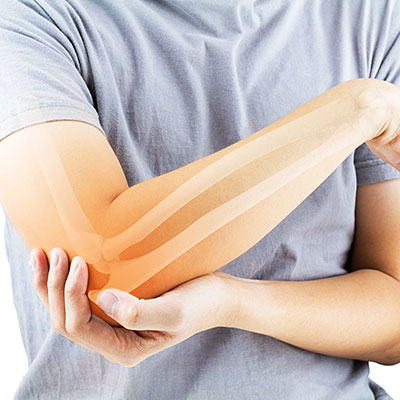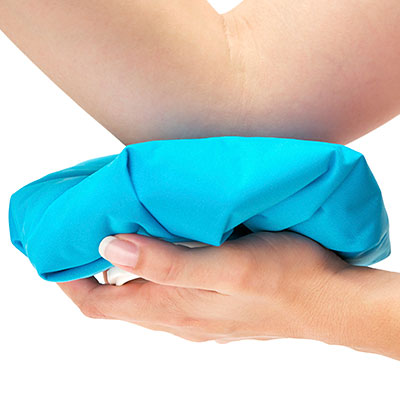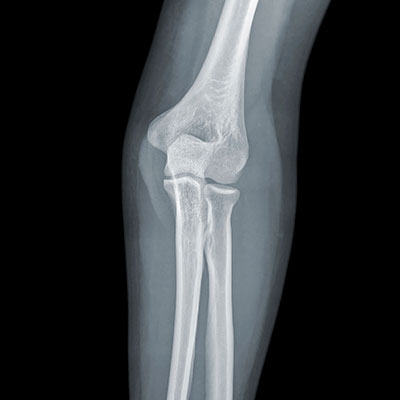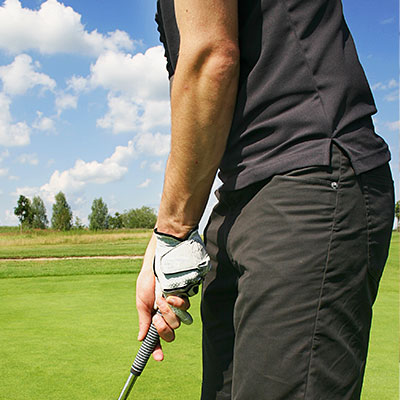Overview
Elbow pain is extremely common – whether due to aging, overuse, trauma or a sports injury. When elbow pain interferes with carrying the groceries, participating in your favorite activities or getting a good night’s sleep, it’s time to seek medical advice.
Elbow anatomy
Your elbow is a hinge joint between the radius and ulna of the forearm, and the humerus of the upper arm. The bones are held together by ligaments. The primary ligaments of the elbow are the medial collateral ligament (MCL) on the inside of the elbow and the lateral collateral ligament (LCL) on the outside. Several muscles surrounding the joint are responsible for movement. The tendons attach the muscle to the bone, the cartilage covers and protects the ends of the bones, and bursa sacs provide lubrication and protection around the joint.
Arthritis

Arthritis is a chronic condition that causes loss of the cartilage that covers the joints. Signs and symptoms include pain and stiffness, as well as swelling, warmth or tenderness at the elbow. The two most common types of arthritis are osteoarthritis and rheumatoid arthritis. Here is a closer look at each:
Osteoarthritis
Osteoarthritis (OA) of the elbow is “wear and tear” arthritis. This is the gradual breakdown of the cartilage in the elbow. Also called degenerative joint disease, osteoarthritis usually develops over years and often is found in patients who have had an elbow injury, such as a dislocation or fracture, or overuse of their joint from their job or sports. The condition is most common in adults over age 50.
Symptoms of OA include pain, stiffness, tenderness, a limited range of motion and a grating sensation when you use your elbow. Pain is usually worse after activity. Joint swelling may occur as the disease progresses.
To diagnose OA, your physician will take your medical history and perform a thorough physical examination, typically including X-rays. Treatment may include acetaminophen or ibuprofen to control the pain, resting the joint, applying heat or cold, bracing and occupational therapy exercises. Surgery may be recommended if the symptoms do not respond well to conservative treatments. Your surgeon will discuss which type of procedure is right for you. Depending on the degree of joint damage, surgery can involve removing bone spurs and cleaning out the joint, a partial (radial head) or total elbow replacement, or elbow resurfacing in more severe cases.
Rheumatoid arthritis
Rheumatoid arthritis (RA) often affects more than one joint, and joints on both sides of the body (such as both knees, both hands and/or both elbows). In most people, symptoms develop gradually over years, although they can appear rapidly. RA affects three to five times more women than men and often occurs between the ages of 20 and 50. The condition may be related to a combination of abnormal immunity and genetic, environmental and hormonal factors.
RA causes inflammation in and around joints, and over time can cause cartilage to wear away, swelling in the synovium (a tissue lining the joint), and excess fluid in the elbow. In later stages, bones can rub against each other and tissues around the joint, such as ligaments and tendons, also can be damaged. All of these factors cause the joint to become very painful, tender, swollen and warm to the touch.
To diagnose RA in your elbow, your physician will take a medical history, including asking about any stiffness in the morning, examine the specific location of your pain, and look for any bumps/nodules under the skin (rheumatoid nodules). You also will undergo X-rays and a blood test for rheumatoid factor, an antibody present in about 70 percent of people with RA.
Treatment includes medications to decrease joint pain, swelling and inflammation and hopefully prevent or minimize the progression of the disease. It also may include rest and exercise, physical therapy/occupational therapy and surgery to correct damage to the joint. The type of treatment prescribed will depend on several factors, including the person’s age, overall health, medical history and severity of the arthritis. As with OA, surgery may be recommended if the symptoms do not respond well to conservative treatments. Your surgeon will discuss which type of procedure is right for you. Depending on the degree of joint damage, surgery can involve removing bone spurs and cleaning out the joint, a partial (radial head) or total elbow replacement, or elbow resurfacing in more severe cases.
Sprains & Strains

A sprain is an injury to a ligament and a strain is an injury to a muscle. Either can involve stretching or a tear.
Strains can be caused by putting too much pressure on the muscles of the elbow joint during lifting, work activities or throwing, racquet or contact sports. Symptoms include pain, swelling, bruising and weakness. Once examined by a physician, strains are treated similarly to sprains.
Sprains are commonly seen in athletes who throw, or play racquet or contact sports. Symptoms of a sprain include point tenderness, looseness in the joint, general joint pain and swelling. A physician can diagnose a sprain through a medical history and examination. Treatment includes rest, ice, antiinflammatory medication, and gentle stretching and strengthening when the athlete is pain-free.
Dislocation

A dislocation is when one of the bones in the elbow joint moves or is pushed out of place due to injury. In the elbow, dislocations are usually caused by a fall on an outstretched arm or another direct blow, such as a car accident. Most elbow dislocations are posterior, meaning the forearm bones are pushed backwards and out of position from the humerus (upper arm bone).
Symptoms of a dislocation include obvious deformity, pain, swelling and loss of motion. The joint should initially be immobilized in the position in which it is found. The injury should be seen immediately in an emergency room, where the elbow can be manipulated back into position by a physician. The arm will need to be kept in a sling for several weeks. Then, occupational therapy exercises are recommended to regain range of motion and decrease the risk of repeat dislocation. Surgery to align the bone, fix broken bones or repair ligaments may be needed in the case of more severe dislocations. Recovery depends on the extent of the surgery and type of procedure performed.
Fractures & Sports Injuries

Elbow fractures
A break, or fracture, of the elbow can affect any of the three bones around the elbow (humerus, ulna and radius). The ulna most commonly fractures at its tip on the back of the elbow (olecranon), while the radius usually breaks near the elbow joint (radial head or neck). One or more of the bones can break with an injury. Elbow fractures most commonly are caused by a direct blow to the elbow (such as a sports injury or car accident) or indirectly by falling on an outstretched arm. Fractures may occur as a part of an elbow dislocation.
Symptoms may include obvious deformity, pain, swelling and loss of motion. However, being able to move the elbow does not rule out the possibility of a fracture. A suspected fracture should be immobilized and examined by a physician. X-rays, MRI or CT scans may be taken to confirm and determine the severity of the injury as well as any other related injuries.
Treatment includes ice, non-steroidal anti-inflammatory drugs and splinting, followed by occupational therapy exercises. Surgery may be needed for fractures that are not well aligned. The type of procedure used and recovery will depend on the severity of the injury.
Little league elbow
This combination of symptoms, rather than one injury in particular, occurs in young pitchers who are still growing. Ten- to 15-year-old pitchers are especially susceptible because they may be in a growth spurt of the “growth plates” in the bones around the elbow. Repetitive throwing can cause this overuse injury, resulting in symptoms of inner elbow pain, weakness in the wrist, swelling and warmth.
An X-ray may be needed to rule out any other complications that would require surgery. Treatment includes rest, ice and bracing. Stretching and strengthening exercises can then help regain function. Recovery may take a few days to a few months, depending on the level of injury.
Little leaguer’s elbow can be prevented with proper strength and conditioning exercises and staying within age guidelines for the types and counts of pitches thrown.
Tennis elbow (lateral epicondylitis)
“Tennis elbow” is a general term that may or may not be related to playing tennis. This term came into use because it can be a significant problem for some tennis players, however, the condition can arise in many other situations. The condition typically is caused by “wear and tear” or overuse of the forearm muscles (wrist extensors) that results in pain at the elbow. It affects the outside (lateral) elbow, most commonly involving the area where the muscles and tendons of the forearm attach to the outside bony area (epicondyle) of the elbow. It can affect the dominant, non-dominant or both arms.
Symptoms include pain that generally grows slowly around the outside of the elbow. Less often, pain develops suddenly. This pain is worse when shaking hands, squeezing objects, holding the wrist stiff or moving the wrist with force (such as when lifting, using tools or a knife and fork).
Tennis elbow is diagnosed by a medical history and physical examination. Treatment may involve rest, ice, non-steroidal anti-inflammatory drugs, cortisone injections, bracing and physical therapy. More advanced treatments (such as patient’s own platelets, shockwave or surgery) may be recommended depending on the length and severity of your symptoms and if they fail to respond to conventional therapy. Typically, surgery is performed on an outpatient basis (requiring no hospital stay) and involves removing or repairing the damaged tendon tissue. A splint will be needed for a week or two after surgery, followed by occupational therapy exercises.
Golfer’s elbow (medial epicondylitis)
“Golfer’s elbow” is a condition similar to tennis elbow that occurs on the inside, rather than the outside, of the elbow. The condition isn’t limited to golfers and involves “wear and tear” of the tendons that attach on the medial epicondyle, the bony bump on the inside of the elbow.
Symptoms include chronic pain on or near the medial epicondyle, and are usually aggravated by flexing the wrist and/or rotating the forearm. The elbow may be tender to touch over the painful area, and the pain can be made worse by movements that stress the involved tendons.
Most cases of golfer’s elbow can be successfully managed by activity modification, non-steroidal anti-inflammatory drugs, occupational therapy, elbow or wrist splinting, and cortisone injections at the elbow, if needed. Surgical treatment may be needed if conservative methods fail to provide relief. The procedure to remove or repair the damaged tendon is performed on an outpatient basis, followed by immobilizing the joint for several weeks and occupational therapy exercises.
Olecranon Bursitis
Olecranon bursitis involves painful inflammation of the bursa (a fluid-filled sac) that provides lubrication and protection around the tip of the back of the elbow. The condition also is known as “Popeye elbow” because of the bump it causes at the back of the elbow – similar to the cartoon character’s exaggerated features.
The condition can be caused by inflammation due to repetitive pressure on the bursa, a direct hit to the elbow or an infection. Symptoms include pain (especially with movement), stiffness, swelling, tenderness, warmth and redness.
Olecranon bursitis is diagnosed by a medical history and physical examination. X-rays may be needed if the inflammation is due to an injury to rule out other complications. A sample of fluid also may be taken and tested for infection.
Treatment for olecranon bursitis that has come on suddenly may include draining the bursa’s fluid and injecting medication to ease inflammation and encourage healing. For persistent olecranon bursitis, changing how you use your elbows may be needed (such as not leaning on them, wearing elbow pads). Anti-inflammatories, antibiotics and/or surgery to drain or remove the bursa also may be needed. A splint will need to be worn for several weeks after surgery, followed by occupational therapy exercises to restore range of motion.
Osteochondritis Dissecans
This condition, most often affecting adolescents, occurs when a segment of the bone separates from its bed in the elbow joint and dies, causing the overlying cartilage to break loose. It is caused by disrupted blood flow to the area, which makes the bone unable to withstand repeated pressure in high-impact sports, although there may also be a genetic component. Symptoms can include unexplained elbow pain, elbow pain following an injury, or a catching and locking sensation in the joint.
Osteochondritis dissecans is diagnosed by X-ray and/or MRI, which can detect the presence of a bone fragment. If the fragment is loose, it may be surgically reattached, if possible, or removed. If the cartilage is still attached, conservative treatment with rest and nonweight bearing exercises are recommended to help healing.
Cubital Tunnel Syndrome
Cubital tunnel syndrome (also known as ulnar nerve entrapment) is a musculoskeletal disorder caused by too much pressure being placed on the ulnar nerve. This nerve is one of three major nerves in your arm. It runs along the inside of your elbow, passing through a tunnel of tissue (cubital tunnel) and around the bony bump on the inside of your elbow (medial epicondyle). When this nerve is subject to long periods of pressure due to leaning or sleeping on your elbow, keeping your elbow bent for long periods, or hitting your “funny bone,” it can cause a burning sensation or numbness in the elbow, arm, hand or fingers.
The syndrome is diagnosed by a medical history and physical exam to check for nerve irritation, strength and feeling in your arm and fingers, whether the nerve slips out of position, and how your upper body movements affect your symptoms. Tests such as X-rays (to look for bone spurs or an area of bone that is compressing the nerve), electromyography (EMG – to evaluate your muscles’ electrical activity) or nerve conduction studies also may be needed.
Treatment may include changing the way you use your elbow, non-steroidal anti-inflammatory medications, bracing and occupational therapy exercises. Surgery to relieve pressure on the nerve may be recommended if conservative treatments fail. Your surgeon will discuss which type of surgical procedure is right for you. The amount of time it takes for symptoms to resolve varies and it may take a few months for strength to return to the arm, hand and wrist.
Radial Tunnel Syndrome
Radial tunnel syndrome is a musculoskeletal disorder caused by too much pressure being placed on the radial nerve in the forearm. The radial nerve runs along the outside of the forearm down to your thumb, index and middle fingers. When this nerve travels through the forearm, it passes through a tunnel of tissue (radial tunnel), which can put pressure on the nerve. When this nerve is subjected to long periods of pressure due to pushing, pulling or twisting motions, or a direct blow to the outside of the elbow, it can cause a burning sensation or numbness in the outside of the forearm and elbow. The condition also can be caused by noncancerous fatty tumors or bone tumors that push on the nerve.
The syndrome is diagnosed by a medical history and physical exam that will differentiate it from tennis elbow, which has similar symptoms but typically in a location closer to the elbow than radial tunnel syndrome. Tests such as X-rays (to look for bone spurs or an area of bone that is compressing the nerve), electromyography (EMG – to evaluate your muscles’ electrical activity) or nerve conduction studies also may be used to help make the diagnosis.
Treatment may include changing the way you use your arm, non-steroidal anti-inflammatory medications, bracing and occupational therapy exercises. Surgery to relieve pressure on the nerve may be recommended if conservative treatments fail. Your surgeon will discuss which type of surgical procedure is right for you. The amount of time it takes for symptoms to resolve varies and it may take a few months for strength to return to the arm, hand and wrist. Splinting will be needed following the procedure, followed by occupational therapy exercises.
Patient Services
MyChart
MyChart is a secure online tool that provides personalized health information from the privacy of your home at any time, day or night. Learn more or login now.
Virtual Visits
You can now stay connected to your healthcare team through virtual visits, using your smartphone, tablet or computer.
Why go virtual? It's an easy, convenient and secure way to see your provider face-to-face without having to leave home. This saves you travel time, parking fees and time spent in the waiting room — and you can also have a loved one or caregiver join you. If appropriate, you can also get a prescription sent to the pharmacy of your choice.
Many insurance companies cover the cost of virtual visits, so check with your insurance company ahead of time. Interested in getting started? Call your provider to find out what virtual visit options are available.
Learn more about virtual visits for scheduled appointments
Virtual Visits with Orthopaedics
New patients with common knee injuries or knee pain.
Established patients scheduling follow-up care appointments such as:
- Post-Surgical & wound check visits
- Fracture care follow-up
- Injection follow-up
- Musculoskeletal injury follow-up
- Per-operative teaching prior to surgery
Appointments
To make an appointment with an elbow specialist, call:
- Cleveland Appointments: 216.444.2606
- Akron Appointments: 330.344.2663
- Canton Appointments: 330.489.1362
- Dover Appointments: 330.343.3335
Virtual Second Opinion
If you cannot travel to Cleveland Clinic, help is available. You can connect with Cleveland Clinic specialists from any location in the world via a phone, tablet, or computer, eliminating the burden of travel time and other obstacles. If you’re facing a significant medical condition or treatment such as surgery, this program provides virtual access to a Cleveland Clinic physician who will review the diagnosis and treatment plan. Following a comprehensive evaluation of medical records and labs, you’ll receive an educational second opinion from an expert in their medical condition covering diagnosis, treatment options or alternatives as well as recommendations regarding future therapeutic considerations. You’ll also have the unique opportunity to speak with the physician expert directly to address questions or concerns.
Why Choose Us?
At Cleveland Clinic's Orthopaedic & Rheumatologic Institute, we offer patients the most advanced treatments for any type of elbow pain. Our institute uses a multidisciplinary team approach, bringing all of the experts that you need together under one roof, including orthopaedic physicians, orthopaedic surgeons sub-specialized in treating elbow disorders, rheumatologists and occupational therapists.
Being part of Cleveland Clinic also means you have easy access to any of our other specialists to manage any related conditions. Our experienced team works closely together and helps develop an individualized plan to best meet your needs. You can take comfort in knowing that our physicians remain the experts at the forefront of developing new approaches to treating elbow pain.